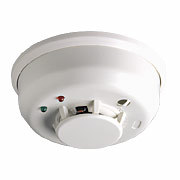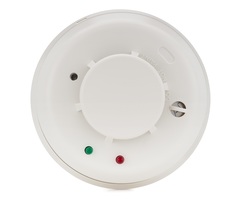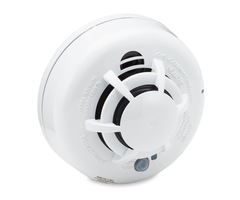The Importance of System Smoke Detectors
Posted By Michael GorisWhen it comes to smoke detectors, these crucial life-safety devices can be split into two main types. These are standalone smoke detectors and system smoke detectors. The difference between these two categories is that system smokes are connected with an alarm system for monitoring.

With a standalone smoke detector, the device is nothing more than a local noise-making device for alerting on-site building occupants to the presence of a fire. However, a system smoke detector will provide a greater level of functionality. In addition to providing an audible alert of a fire, a system smoke will also cause a fire alarm on the system with which it is programmed.
With that in mind, a system smoke detector is the only type of smoke detector that can send alerts to the end user and/or a central monitoring station about any fire that has occurred in a building. This means that system smoke detectors are the only devices that can request automatic fire dispatch from a central station or alert off-site users to the presence of a fire.
Both system and standalone smoke detectors can include a feature known as "one-go, all-go". This feature means that the smoke detectors are interconnected, and if one smoke in the network activates, the others will activate as well. The one-go, all go function can be very important for ensuring that the entire building is alerted to a fire. Traditionally, this feature was only available for hardwired smokes. But in more recent years, wireless smoke detectors, like the Honeywell SiXSMOKE, have adopted this feature as well.

As a company that deals with alarm systems and monitoring, Alarm Grid specializes in system smoke detectors. We believe that it is very important that people use system smoke detectors over standalone smokes. If a fire occurs when there is nobody in the building, only a system smoke can alert those who aren't on the premises. This is very important for ensuring that the situation is under control and that the fire does not spread to surrounding areas. And for customers who are connected with a central station, system smokes will allow them to receive automatic emergency fire dispatch in the event of a fire.
However, there is a way to essentially turn standalone smoke detectors into system smoke detectors. This is accomplished using a takeover module. A takeover module is a type of wireless sensor that listens for the sound of an activated smoke detector. If a takeover module picks up this type of sound, it will send an alert to the alarm system to let it know about the fire. This will allow a standalone smoke detector to function as a system smoke detector with an alarm system. One example of a smoke detector takeover module is the Encore FireFighter FF345. This wireless device will send a 345 MHz wireless signal so that a standalone smoke detector can communicate with a compatible alarm system.
 Remember, while standalone smoke detectors can be very useful for alerting building occupants, only a system smoke detector can request emergency help when nobody is on-site. Alarm Grid offers a great selection of system smoke and heat detectors that are designed for use with alarm systems. Protect your home or business, and get one today!
Remember, while standalone smoke detectors can be very useful for alerting building occupants, only a system smoke detector can request emergency help when nobody is on-site. Alarm Grid offers a great selection of system smoke and heat detectors that are designed for use with alarm systems. Protect your home or business, and get one today!







